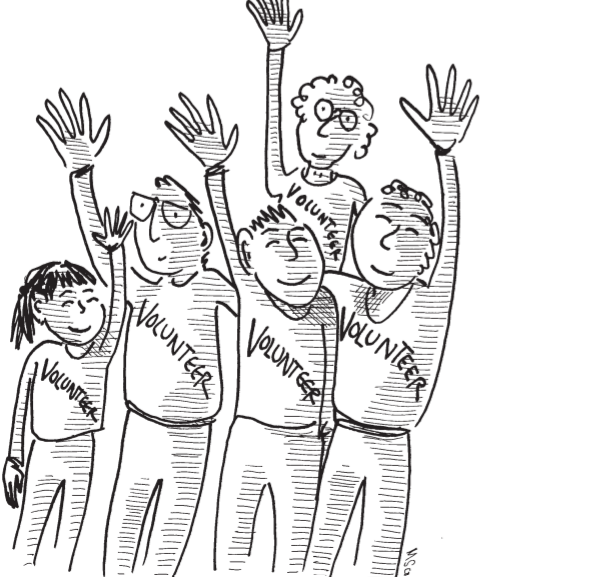“Have you done any volunteer service with an organization to help improve the lives of people in your community?”
When we asked this question of our union officers and stewards, they mentioned volunteering for their school, church, or club. Some shook their heads, embarrassed to say they did nothing. Not one of them said they did volunteer service for their union. Yet every one of them spends many hours every month helping their fellow workers.
The unpaid work they do for their co-workers and the union fits the definition of voluntary, community service in every way. They receive no pay for their time. The work they do improves the lives of people in their community. When we point this out to them, they look surprised. It never occurred to them to think of their service in this way.
Thank you, to all the union members who give their time, energy, and hearts to improve the lives of working people. Thank you, for standing up to defend the rights of your fellow workers. Thank you, for your efforts to better the wages, benefits, and conditions of hundreds of workplaces in Hawaii.
All of you deserve our recognition and thanks for your volunteer service.
A survey conducted by the Corporation for National and Community Service in 2007 counts volunteerism as “any unpaid activity for any organization.” This volunteer service did not have to help the community or improve lives. It could include selling huli-huli chicken to buy uniforms for your child’s soccer team or organizing a barbecue for your motorcycle club. Volunteerism could include serving the food at a church luncheon.

The survey was introduced as follows: “This month, we are interested in volunteer activities, that is, activities for which people are not paid, except perhaps expenses. We only want you to include volunteer activities that you did through or for an organization, even if you only did them once in a while.”
Following this introduction, people were asked the first question: “Since September 1st of last year, have you done any volunteer activities through or for an organization?”
If people did not answer “yes” to the first question, they were asked the following question: “Sometimes people don’t think of activities they do infrequently or activities they do for children’s schools or youth organizations as volunteer activities. Since September 1st of last year, have you done any of these types of volunteer activities?”
People in the survey were considered volunteers if they answered “yes” to either of these questions.
The government survey defines organizations as associations, societies, or groups of people who share a common interest. Examples include churches, synagogues, and other religious institutions, youth groups, and civic organizations.
Hawaii Volunteerism
According to this survey, Hawaii had a volunteerism rate of 25 percent. Most of their volunteerism was with educational, youth, religious, hospitals, and social groups. The most common activity was fundraising or preparing and serving food.
Utah had the highest volunteerism rate of 46 percent, where almost half of their adult population said they did volunteer work. Hawaii’s volunteerism rate of 25 percent put us near the bottom at number 43. The state of Nevada had the lowest volunteerism rate of 17.5 percent.
Volunteers are defined as persons who performed unpaid volunteer activities at any point during the last 12 months, from September 1 of the prior year through the survey week in September of the survey year. The count of volunteers includes only persons who volunteered through or for an organization; the figures do not include persons who volunteered in a more informal manner.
For more information about the survey, see:
http://www.nationalservice.gov/ about/volunteering/states.asp ◆
Maui Pine Cannery workers qualify for benefits—cont. from page 1
approved the ILWU’s petition on July 25, 2007. The ruling covers all Kahului Cannery workers who lost hours or their jobs on or after May 8, 2006, and continues for two years until July 25, 2009. This means eligible workers may apply for assistance anytime within this two year period.
Benefits include
In addition to the regular 26 weeks of state unemployment insurance, laid off Maui Pine workers are eligible to receive: 1) free retraining and assistance in finding a new job; 2) reimbursement of expenses in seeking work outside of their normal commuting area; 3) relocation expenses if the worker must move to get a new job; 4) free training up to a maximum of 104 weeks including an additional 26 weeks if basic education is required; 5) income support while a worker is receiving full-time training (this must be done within 8 weeks of certification); 6) a tax credit of 65 percent of the monthly health insurance premium.
Eligible workers over age 50 may also receive a wage subsidy if they get a new, full-time job that pays less than their old job.
Maui Pine members should contact the State’s Rapid Response Unit on Maui at 984-2091 for information and help in applying for these benefits.
There are deadlines for applying for these benefits, so don’t wait until it’s too late. If you have any questions, call the ILWU ILWU Maui Division Office at 808-244-9191 or the ILWU’s social services coordinator Joanne Kealoha at 808-949-4161.
Imports cause job loss
Maui Pineapple was the only company still canning pineapple in the US, as other companies such as Dole and Del Monte have long moved their canning operations overseas. In recent years, the cheaper, imported canned pineapple has been hurting sales of Maui Pineapple’s canned products.
As a result, the company closed its cannery operations on July 31, 2007, and laid off 120 workers. The company had already cut 150 cannery jobs in January 2005, when it scaled back its cannery operation. Maui Pineapple will continue to grow and sell pineapple as fresh fruit and juice. ◆
